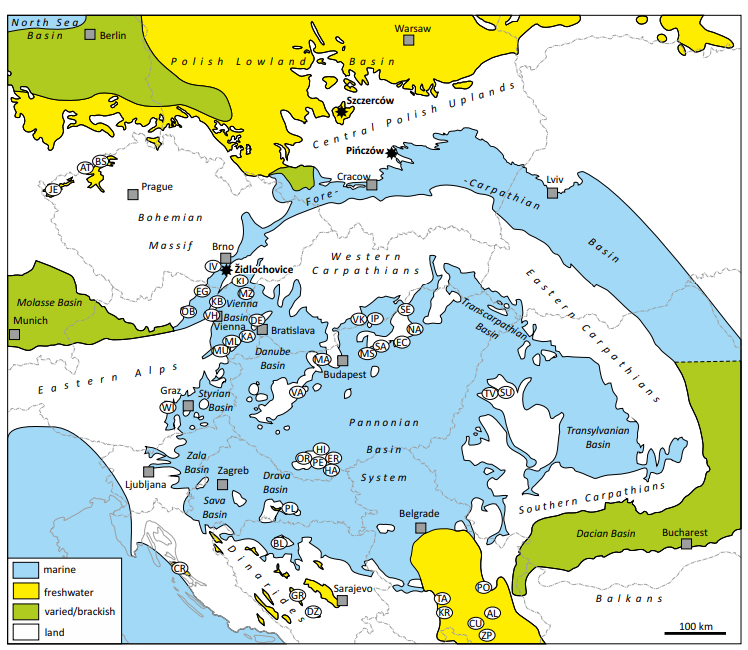Keep our news free from ads and paywalls by making a donation to support our work!

Notes from Poland is run by a small editorial team and is published by an independent, non-profit foundation that is funded through donations from our readers. We cannot do what we do without your support.
Researchers have discovered the remains of a 17-million-year-old reptile, an extinct relative of modern crocodiles and alligators, in Poland’s largest coal mine. The discovery marks the northernmost known occurrence of such an animal from that period.
The Polish and Czech team behind the discovery of the fossil, who have just published their findings in scientific journal Acta Palaeontologica Polonica, believe that the fossil belongs to a diplocynodon, an extinct part of the crocodilia order of reptiles.
Szczątki krokodyla sprzed 17 mln lat odnaleziono na terenie kopalni „#Bełchatów”. #naukahttps://t.co/8CUDdfS4Ob pic.twitter.com/EIcGs2vnb6
— Dzieje.pl (@dziejepl) May 25, 2025
The fossil, a fragment of skin armour known as an osteoderm, was found in June 2023 in lakebed sediments at Bełchatów mine, which supplies Poland’s – and Europe’s – largest coal-fired power plant.
“At first, it resembled an ordinary piece of bone. It was only when we dissected it and looked at its other, very distinctive side that there was no longer any doubt that it was a crocodile skin plate,” Marcin Górka of the University of Warsaw told the Polish Press Agency (PAP).
Measuring just 30 millimetres across, the tiny fossil fragment was difficult to spot in the vast excavation site in the mine. It is now being kept at the Museum of the Faculty of Geology at the University of Warsaw.
“Mine visits are always associated with danger. We realise that we are a bit of a burden for the workers and the management… So we are incredibly grateful for being allowed to do this work,” said Górka.
The find represents the most northerly crocodilian fossil from the Miocene era ever recorded (though older remains from the Cretaceous period have been discovered as far north as Sweden).
The Miocene lasted from around 23 million to 5.3 million years ago and was relatively warm and humid, with temperatures estimated to be 3 to 4 degrees Celsius higher than today, supporting lush vegetation and diverse fauna.
Crocodilians of the Miocene included the large marine Gavialosuchus, which reached over six metres, and the smaller freshwater Diplocynodon, typically between 1.5 and 3 metres.

Prevailing environments of the main palaeogeographic units of the Central Paratethys and adjoining areas in the Early-Middle Miocene time. Source: Acta Palaeontologica Polonica, “Crocodylian remains from the Miocene of the Fore-Carpathian Basin and its foreland –including the world’s northernmost Neogene crocodylian”
“The plate we found does not have 100% of the features that could indicate which genus we are dealing with,” said Górka. “However, it was most likely a diplocynodon – a relative of modern alligators. We think so because, like modern alligators, it had a higher tolerance to cold, meaning it could have occurred further north.”
The study published by Górka and his colleagues also references earlier crocodilian finds, including a tooth discovered in the early 1970s in the Polish town of Pińczów and another from Židlochovice in the Czech Republic, both dating to around 14 million years ago.
All three fossils are pictured in the main photo of this article, with the tooth from Židlochovice marked as A, the tooth from Pińczów as B, and the Szczerców osteoderm marked as C.
Europe's oldest known zoo animal, Marta the alligator, will celebrate her 95th birthday in Poland tomorrow.
Marta, who first arrived at Płock Zoo in 1960, has outlived the typical lifespan of her species by decades https://t.co/pYTj6ug9LY
— Notes from Poland 🇵🇱 (@notesfrompoland) May 16, 2025

Notes from Poland is run by a small editorial team and published by an independent, non-profit foundation that is funded through donations from our readers. We cannot do what we do without your support.
Main image credit: Acta Palaeontologica Polonica 70 (2), 2025 “Crocodylian remains from the Miocene of the Fore-Carpathian Basin and its foreland—including the world’s northernmost Neogene crocodylian” (under CC BY 4.0)

Alicja Ptak is senior editor at Notes from Poland and a multimedia journalist. She previously worked for Reuters.



















